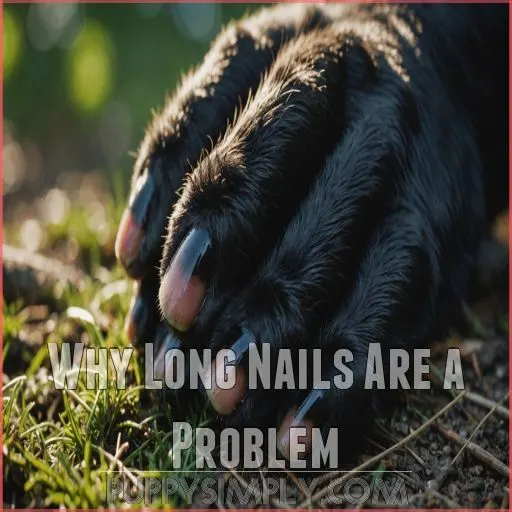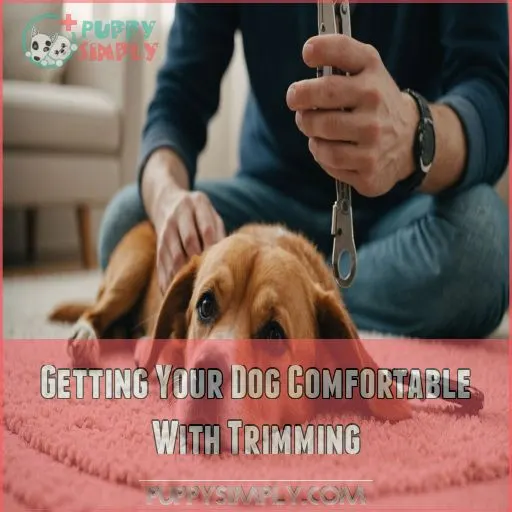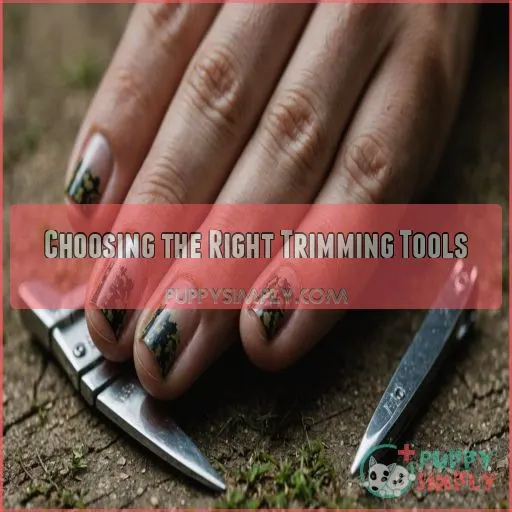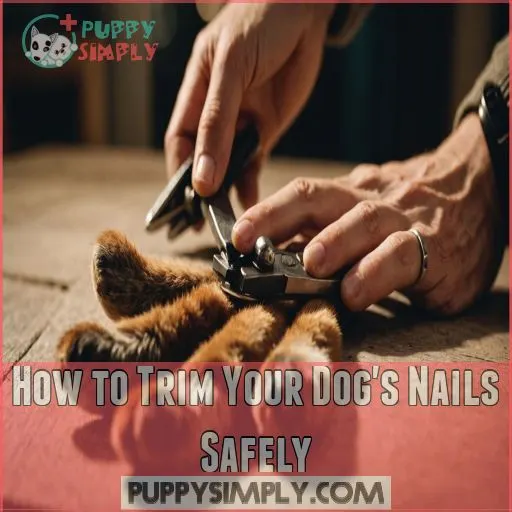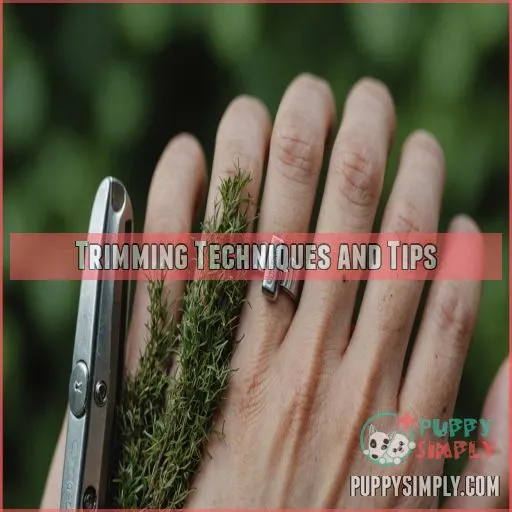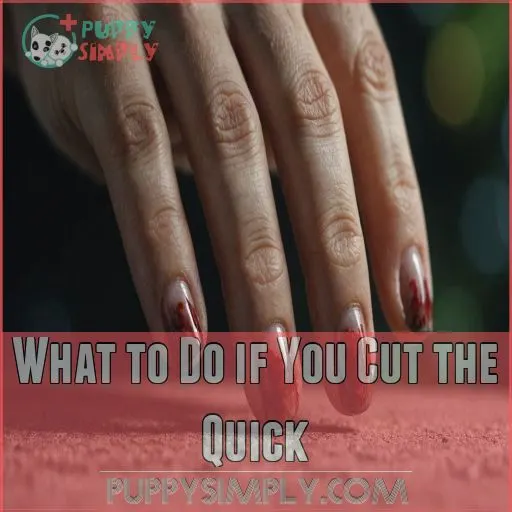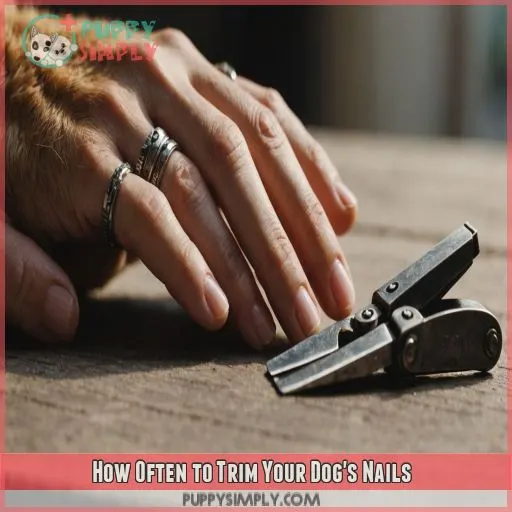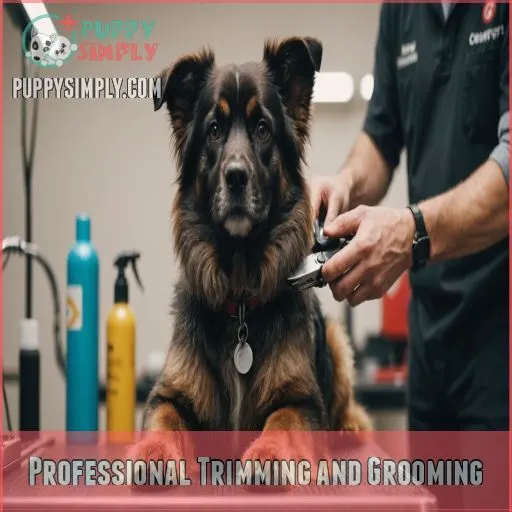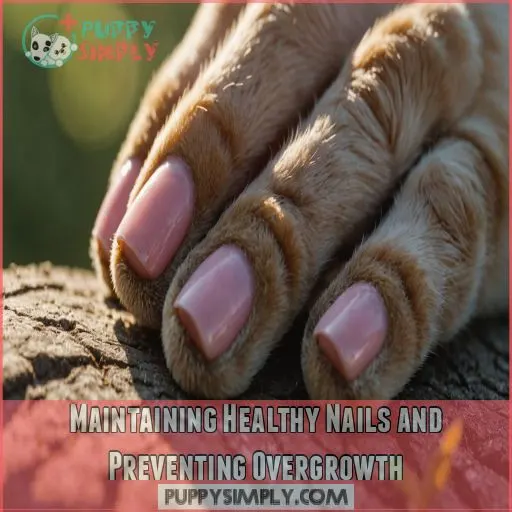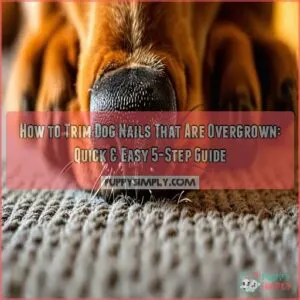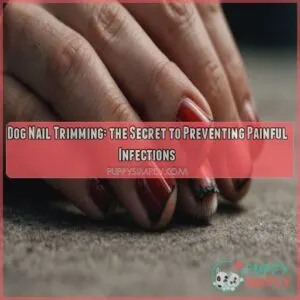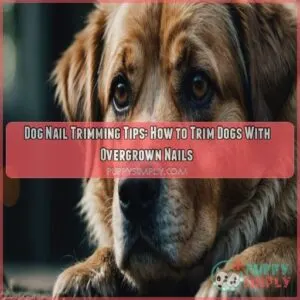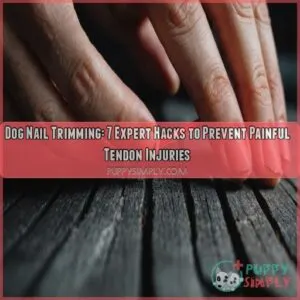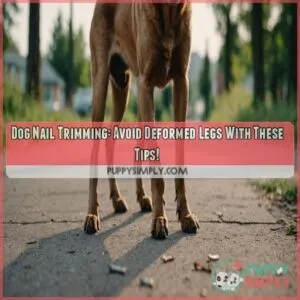This site is supported by our readers. We may earn a commission, at no cost to you, if you purchase through links.
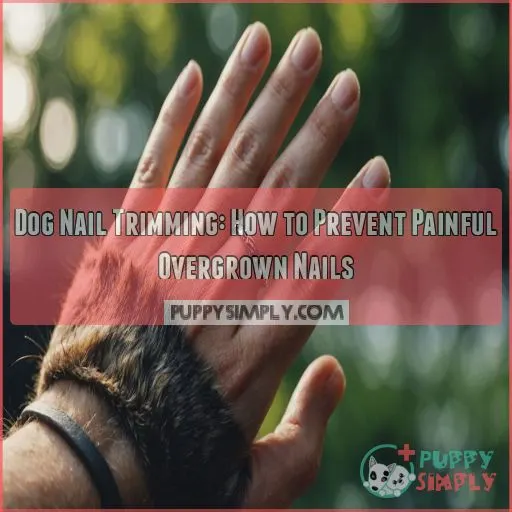
Like giving your pet a quick pedicure, start by getting your pup comfy with the tools—let them sniff and explore.
Use treats as bribes… err, rewards, and maintain a calm vibe.
Choose the right clippers for their paw size and clip nails every 2-4 weeks.
Always trim in a well-lit area to spot the sensitive quick, and never forget the “unicorn” of claws—the dewclaw!
Consistent trims keep your dog’s nails in tip-top shape, sparing them discomfort and potential paw-sitively awkward walks.
Want the juiciest nail care tips? Keep reading!
Table Of Contents
- Key Takeaways
- Why Long Nails Are a Problem
- Getting Your Dog Comfortable With Trimming
- Choosing the Right Trimming Tools
- How to Trim Your Dog’s Nails Safely
- Trimming Techniques and Tips
- How to Identify the Quick
- What to Do if You Cut the Quick
- How Often to Trim Your Dog’s Nails
- Professional Trimming and Grooming
- Maintaining Healthy Nails and Preventing Overgrowth
- Frequently Asked Questions (FAQs)
- How do you prevent overgrown nails in dogs?
- How to trim a dog’s nails when they are too long?
- How do I stop my dogs nails from growing?
- How to make dog nails quickly recede?
- What are signs my dog needs nail trimming?
- Can diet affect my dogs nail health?
- How can exercise help maintain nail health?
- Are there signs of nail infection to watch for?
- What environmental factors influence nail growth rate?
- Conclusion
Key Takeaways
- Get your dog used to nail trimming tools by letting them sniff and explore, using treats to create a spa-like atmosphere. Picture each session like a delightful doggy pedicure – calm vibes and all.
- Regular trimming every 2-4 weeks prevents discomfort and awkward walks; think of it as keeping those paws runway-ready. Use the right clippers based on paw size and always watch out for that infamous "unicorn," the dewclaw.
- Don’t hesitate to call in the pros if trimming feels like an Olympic sport. Professional groomers can turn a paw-dicure into a breeze, addressing nail health issues while you and your pup relax.
- Keep an eye on nail length; if they’re clicking on the floor, it’s time for a trim. A healthy diet and regular exercise help, too – nature’s way of keeping those claws in check without any hassle.
Why Long Nails Are a Problem
Long nails on your dog aren’t just a fashion faux pas—they can cause serious discomfort and even lead to infections.
By keeping their nails trimmed, you’re helping them strut their stuff without the painful side effects of overgrown claws.
Discomfort and Pain
Long nails can spell trouble for your pup! They lead to discomfort, joint pain, and even nail infection. Here’s what happens:
- Overgrown nails dig into paw pads.
- They trigger dog nail trimming anxiety.
- Unseen damage leads to dog nail trimming discomfort.
Impact on Movement and Mobility
Overgrown nails can make it tough for your pup to get around.
Those long claws put extra pressure on their joints, making it harder to walk, run, and play with ease.
Distortion of Feet or Damage to Tendons
Overgrown nails aren’t just a pain—ouch, they can warp a dog’s feet and hurt tendons. Watch for:
- Splayed toes
- Walking difficulties
- Limping
- Changes in gait
Keep trimming those nails!
Risk of Infection
You wouldn’t want your dog’s paws to become a bacteria party, right? Untrimmed nails encourage paw licking, increasing bacteria buildup.
Regular dog nail trimming at home or professional visits can prevent infections and keep paws clean.
Getting Your Dog Comfortable With Trimming
Getting your dog comfortable with nail trimming can feel like you’re negotiating a peace treaty, but patience and treats are your best allies.
By introducing the tools slowly and associating the experience with positive rewards, you’ll have your pup paw-sitively excited for mani-pedis in no time!
Introduce Trimming Tools Slowly
Start by letting your pup sniff and inspect the nail clippers. This gradual introduction helps them get comfortable with the trimming tools, setting the stage for a positive experience.
Associate Trimming With Positive Experiences
Now that you’ve introduced the tools, it’s time for positive reinforcement.
Use treats as rewards during dog nail trimming training.
Imagine each trim as a spa day, and manage anxiety with patience and playfulness.
Desensitize Your Dog to Trimming Tools
Some dogs really hate nail trimming tools—it’s like catnip for anxiety, especially if you’ve never introduced them to clippers before. Gradual exposure helps. Show the tools during playtime. A positive association will form, encouraging calmness. Patience is your secret weapon.
Reward Your Dog With Treats
Rewarding your pup with treats makes nail trimming a breeze. Goodies can transform this dreaded task into a treat-filled adventure they love.
Treat training tips include:
- Positive reinforcement
- Best dog treats
- Perfect treat size
- Ideal treat frequency
Choosing the Right Trimming Tools
Choosing the right trimming tools is really important for your dog’s comfort and safety.
From guillotine clippers for beginners to scissor-type and clamp-type options for professionals, selecting the appropriate tool can make all the difference in providing a stress-free nail trimming experience.
Types of Dog Nail Clippers
Wondering which dog nail clippers suit your furry friend best? Guillotine vs. scissor—the debate rages on. Clip size matters, you know. Maintain your tools, or risk overgrown nails. DIYers, clip confidently: trim wisely!
Using Guillotine Clippers for Beginners
Guillotine clippers are beginner-friendly for dog nail trimming.
They’re a nail-care tool that’s easy to use and minimizes dog anxiety.
- Cuts nails cleanly without fuss
- Simple clipper adjustment mechanism
- Safer for overgrown nails
Selecting Scissor-type Clippers for Short Nails
Scissor-type clippers are your go-to for small and delicate paws! Perfect for maintaining your pooch’s nail length while making sure safety. Remember, size matters based on dog breed. Avoid overgrown nails and achieve masterful trims.
| Clipper Type | Suitable For | Safety Tip |
|---|---|---|
| Small | Small breed dogs | Firm grip for precision |
| Medium | Medium breed dogs | Trim slowly, mind the quick |
| Large | Large breed dogs | Make sure clippers are sharp and clean |
| Basic Model | Puppies | Use treats to comfort and distract |
| Heavy-Duty | Senior dogs | Be gentle, especially with seniors |
Clamp-type Clippers for Professionals
Clamp-type clippers are the pros’ choice – sturdy, precise, and designed to tackle even the toughest nails.
With proper care, these tools help you get a safe, efficient trim every time.
- Durable construction for frequent use
- Precise cutting action for clean, even nails
- Adjustable tension for customized control
- Ideal for thick or overgrown nails
How to Trim Your Dog’s Nails Safely
Trimming your dog’s nails can be an art, especially when trying to keep calm hands and paws.
But fear not—by ensuring your furry friend is relaxed and using some strategic lighting and gentle grips, you’ll be avoiding accidental "oops" moments that neither of you’ll enjoy.
Trim When Your Dog is Calm and Relaxed
When your dog’s more zen than a monk on vacation, it’s nail-trimming time!
A calm dog equals a smoother experience, so use calming techniques and patience.
Rewards? Absolutely! Positive associations make nail trimming a breeze.
Choose a Well-lit Area for Trimming
Good lighting is your best friend when trimming nails.
It helps prevent accidental quick cuts and dog nail trimming bleeding.
A well-lit area makes the task safe and comfortable, making the task a walk in the park.
Hold the Dog’s Paw Firmly but Gently
Firmly yet gently hold your pup’s paw close to their body.
This helps prevent them from pulling away during the nail trimming process.
Stay calm and reassuring – your dog will pick up on your energy.
Identify the Quick and Trim Carefully
Once you’re holding the paw securely, it’s like finding the treasure map’s "X"—locate the quick! Avoid cutting into it by following these tips:
- Quick identification: Look for the pink area.
- Trimming angle: Follow the nail’s shape.
- Bleeding prevention: Have styptic powder ready.
- Grooming tips: Be patient, especially with anxious dogs.
Trimming Techniques and Tips
When trimming your dog’s nails, cut small sections at a time; this prevents hitting the sensitive quick and keeps the process stress-free.
Remember, it’s not a race—be quick and steady with the clippers, and always have treats handy as a reward for your dog’s cooperation.
Trimming Small Sections of the Nail
When you start trimming your dog’s nails, remember that trimming small sections of the nail is key.
Think of it like pruning a delicate rose bush.
This helps avoid hitting the quick and helps keep the nail shape natural, enhancing their health and happiness.
Be Quick and Steady With the Clippers
Be quick and steady with the clippers to trim your dog’s nails safely, following the steps for safe trimming. Avoid hesitation, which can lead to uneven cuts or accidental nicks. Maintain a firm but gentle grip on their paw to keep them still.
Trim in one smooth, decisive motion.
- Trim in one smooth, decisive motion.
- Keep the clippers perpendicular to the nail.
- Check the angle and adjust as needed.
Reward Your Dog With Praise and Treats
Through positive reinforcement, reward your dog with treats and praises to make nail trimming a tail-wagging experience. A little extra love goes a long way!
| Tip | Detail |
|---|---|
| Treat Alternatives | Try carrots or apple slices |
| Reward Frequency | Reward after each paw |
| Consistency Matters | Make it a routine |
How to Identify the Quick
Spotting the quick in your dog’s nails is really important to avoid causing discomfort or pain—think of it as the nail’s no-cut zone!
Look for the sensitive pink area or a small black dot, and trim slowly; your dog will thank you for the careful attention.
Look for the Sensitive Pink Area
Identifying the quick can feel like spotting a ghost—elusive yet important!
Look for a subtle, sensitive pink area within their nail.
Think of it as the treasure map in nail anatomy.
When trimming, avoid the quick to make sure safe, pain-free sessions.
Check for a Grayish-pink Oval or Small Black Dot
Look for a grayish-pink oval or small black dot – that’s the quick, the sensitive area you’ll want to avoid when trimming. Pay close attention to this important nail anatomy to prevent painful mistakes.
Trim Carefully to Avoid Cutting the Quick
Spotting a grayish-pink oval or black dot helps when dog nail trimming.
Trim carefully, channeling your inner Picasso with a precise technique.
Here’s a handy table for quick identification:
| Color | Location | Significance |
|---|---|---|
| Grayish-pink | Near nail tip | Approaching quick |
| Black dot | Nail’s center | Quick boundary |
| Pink | Whole nail area | Entire quick |
What to Do if You Cut the Quick
Accidentally cutting into the quick during a nail trim can feel like a disaster, but don’t worry, it’s a common mishap and not the end of the world.
Grab some styptic powder or cornstarch to stop the bleeding, and remember, even professional dog groomers have been in the same boat.
Use Styptic Powder or Cornstarch to Stop Bleeding
Accidentally cutting the quick can happen to the best of us when trimming your dog’s nails. Don’t fret! You’ve got styptic powder or good ol’ cornstarch on standby for bleeding control.
Simply:
- Dab the styptic powder onto the bleeding nail.
- Apply gentle pressure to stop the bleeding.
- If you don’t have styptic powder, use cornstarch.
- Keep the paw elevated for a moment.
It works like a charm!
Seek Professional Help if Bleeding Doesn’t Stop
If the bleeding doesn’t stop, don’t panic – that’s when you’ll want to call in the pros. Your vet or a professional groomer can properly address the issue and make sure your pup’s paw heals up safely.
Keep some styptic powder or cornstarch on hand just in case, but don’t hesitate to get expert help if needed.
How Often to Trim Your Dog’s Nails
Keeping your dog’s nails in check isn’t just a beauty regimen—it’s essential for their comfort and health.
Regular mini-pawdicures, usually every 2-4 weeks, keep those claws from tapping a noisy reminder on your hardwood floors and help avoid the dreaded overgrowth.
Trimming Frequency Based on Dog’s Individual Needs
Just like a fashion statement, dog nail trimming frequency varies with breed, nail growth rate, activity level, age, and health issues.
For active pups, trim bi-weekly; couch potatoes, monthly.
Overweight dogs may need more frequent trims.
Keep those claws in check!
Monitoring Nails for Signs of Overgrowth
Regular trimming frequency depends on your dog, but keeping an eye on their toenail length helps.
Overgrown nails cause discomfort and affect mobility.
Check for:
- Nail splitting or cracking
- Quick growth
- Color changes
- Long nails touching the floor
- Paw discomfort
Scheduling Regular Trimming Sessions
Schedule nail trims every 2-4 weeks based on your pup’s needs.
Puppies, seniors, and active dogs may require more frequent trims.
Monitor nails closely and trim before they touch the ground when walking.
Consistent care keeps those tootsies happy and healthy!
Professional Trimming and Grooming
If trimming your dog’s nails feels like an extreme sport, it’s time to call in the pros!
Professional groomers can confidently manage your pet’s paw-dicures, addressing anything from overgrowth to nail health issues, while you both chill out.
Benefits of Professional Trimming
When your dog gives you the "Are you serious?" look, consider professional trimming for nail health. Experts make the process stress-free while you save time. Here’s why it’s a smart choice:
- Skillful paw care.
- Efficient dog nail trimming.
- Prevent overgrown nails.
- Peace of mind.
Professional Groomers’ Experience and Confidence
Trust the experience of professional groomers who, armed with specialized training and trimming tools, turn nail shaping into an art.
With patience and skill, they ease dog anxiety, earning client trust and preventing the distress of overgrown nails, keeping your furry friend comfortable.
Addressing Underlying Issues or Concerns
When you enlist a professional groomer, they can address any underlying issues or concerns about your dog’s nail health, ensuring a safe and comfortable trimming experience designed for your pup’s unique needs.
Their expertise makes all the difference.
Maintaining Healthy Nails and Preventing Overgrowth
Keeping your dog’s nails healthy means regular trims and a bit of patience; you don’t want their nails to become skyscrapers that pierce the heavens!
Use clickers or verbal cues during short handling sessions to make this nail-biting experience (pun intended) stress-free for both you and your furry friend.
Regular Trimming and Monitoring
Keep an eye on your dog’s nail growth rate like a hawk to make sure nail health is good.
Evaluate trimming frequency based on each dog.
Engaging with dog nail trimming tools regularly can prevent overgrowth in social or retired dogs, including purebred companions.
Using Clickers or Verbal Cues for Trimming
Just like regular trims, using clicker training with positive reinforcement can work wonders for your dog.
A consistent verbal cue helps your furry friend associate good behavior with treats.
With timing techniques mastered, you’ll nail dog behavior control every time.
Practice Short Sessions of Handling and Trimming
Practice short sessions of handling and trimming your pup’s paws to build their tolerance. Start slow, reward with treats, and be patient – Rome wasn’t built in a day!
4 tips:
- Desensitize gradually
- Associate it with positives
- Keep sessions brief
- Praise and reward
Frequently Asked Questions (FAQs)
How do you prevent overgrown nails in dogs?
Trimming your dog’s nails regularly is like a spa day for them, keeping discomfort at bay and preventing those pesky overgrown talons. Create positive experiences, use proper tools, and assess need frequently for those smooth, silent walks.
How to trim a dog’s nails when they are too long?
Don’t fret – we’ve got this!
Gently hold your pup’s paw, identify the quick, and trim small sections at a slight angle.
Reward their patience with treats, and you’ll both feel better in no time.
How do I stop my dogs nails from growing?
Keeping your dog’s nails short is like maintaining a well-manicured lawn — it requires regular attention.
Schedule trims every 2-4 weeks, monitor nail length, and use treats to ease the experience, reducing overgrowth naturally.
How to make dog nails quickly recede?
You’re probably worried about painful trimming, but fear not!
Gently filing your dog’s nails a couple of times a week can help the quick recede naturally.
Regular walks on hard surfaces keep nails in check too.
What are signs my dog needs nail trimming?
When your dog’s nails click on hard surfaces or grow long enough to touch the ground, it’s time for a trim.
Overgrown nails can cause discomfort and mobility issues—think of them as tiny stilts for your pup.
Can diet affect my dogs nail health?
Believe it or not, your dog’s diet can play a pivotal role in their nail health.
A balanced, nutrient-rich diet helps strengthen nails and prevent brittleness, so keep an eye on what’s on their plate.
How can exercise help maintain nail health?
Exercise is important for your dog’s nail health; it naturally wears down nails, preventing overgrowth.
Exercise is the magician’s spell that keeps your dog’s nails trimmed and paws happy, enhancing comfort and mobility effortlessly.
Are there signs of nail infection to watch for?
Spotting nail infection is key: watch for redness, swelling, discharge, or a foul odor.
If your dog’s nails seem tender or they’re limping, it’s time to channel Sherlock Holmes and investigate further with care.
What environmental factors influence nail growth rate?
Factors like diet, exercise, and even the surfaces they walk on influence nail growth.
Keep them active and trim-ready so those claws don’t get too wild.
Conclusion
Coincidentally, you’ve just read the ultimate guide to preventing painful overgrown dog nails by learning how to use dog nail clippers.
With the right tools, techniques, and a little patience, you can keep your pup’s paws in tip-top shape.
So, don’t let those claws get out of control – stay on top of your dog’s nail care for a lifetime of happy, healthy walks.

